2018 Land Rover Discovery Td6 HSE Luxury
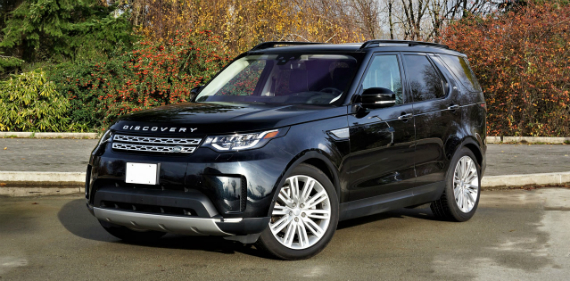
Land Rover sold 2,532 examples of its Discovery in the U.S. from January 1 to March 31 of 2018, increasing deliveries by 570 percent over the same three months of 2017 and dropping sales by almost 27 percent through Q1 of 2016, both being quarters when its mid-size seven-passenger challenger was the extremely well-proven yet still cult favored LR4.
Guilty as charged, I’m part of that LR4 cult, and it seems, by sales numbers at least, that I’m far from alone. Of course, there are a lot of factors that can skew such statistics, in this case the 2017 LR4 numbers challenged by a lack of inventory (it was being phased out), hence my need to go back to 2016 in order to get relevant delivery totals, but that still doesn’t explain why the all-new Discovery is currently losing ground against an SUV dinosaur after nearly a year on the market.
Yes, the LR4’s once traditional SUV shape has now become a radically unconventional box, and therefore it’s made way for an entirely new, thoroughly modernized, sleeker, sportier, and yes, now more conventional luxury SUV. Truth be told, the new fifth-generation Discovery has won me over. It’s just so much more livable than its predecessor that it became plain silly to stay loyal to the old beast.
Driving a regular route around my west coast home makes it look as if 2,000 of those 2,532 Discoverys found their way here, not to mention most of the 6,398 sold over the final seven months of last year, but without doubt a good assortment have been snapped up in other premium SUV hotspots around the nation as well. Time will tell if the new Discovery starts to achieve some sales traction after two years of the LR4 actually gaining ground, but things should begin picking up as more families realize this new kid on the luxury block is now available and that it’s well worth their attention.
Despite only being in its second model year, the 2018 Discovery comes to market with some important updates to make sure such interested parties are as impressed as possible, starting with changes to its base SE trim that now gets a two-inch larger 10-inch infotainment touchscreen with navigation as standard equipment, a move that makes this display standard across the entire Discovery range. What’s more, autonomous emergency braking is standard too, while that base SE model now gets the optional advantage of Land Rover’s highly efficient Td6 six-cylinder turbocharged diesel.
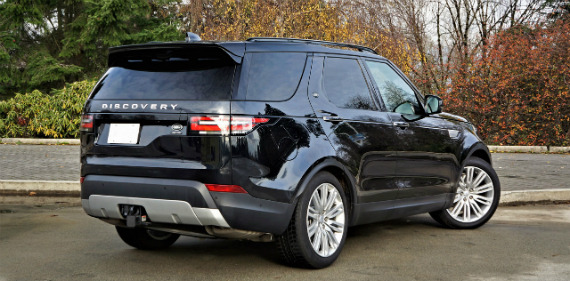
The standard SE model’s improvements have pushed its base price up from $50,985 last year to $52,090 today, a difference of $1,105, but I’m sure most will agree that improved infotainment and potentially lifesaving advanced safety are well worth the extra cost.
Moving up through the range, both HSE and HSE Luxury trims can now be upgraded with Land Rover’s new second-generation head-up display system, which was much appreciated in my tester, as well as a 12.3-inch configurable TFT primary gauge cluster, while the brand’s innovative Activity Key is available for adventurous owners who’d rather leave their key fob safely and securely in the car and wear the waterproof digital bracelet around their wrist instead.
My 2018 Discovery Td6 HSE Luxury tester came equipped with the more economical turbo-diesel, this engine’s very reasonable $2,000 increase making it financially justifiable due to fuel savings that should be recoupable over a few years of ownership. The numbers speak for themselves, with the alternative powerplant good for a claimed 21 mpg in the city, 26 on the highway and 23 combined, compared to 16 city, 21 highway and 18 combined with the base gasoline-powered V6. Depending on how much you drive, the annual savings could be in the high hundreds. On that note both look downright stingy compared to the old LR4, which was soldiering along with an EPA rating of 15 city, 19 highway and 16 combined before its era came to a complete stop last year.
Like with all diesel powerplants, high-speed thrust gets traded for low-speed twist, the base 3.0-liter supercharged V6 good for 340 horsepower and 332 lb-ft of torque compared to 254 horsepower and 443 lb-ft of torque for the 3.0-liter turbo-diesel, while both come mated to a ZF-sourced eight-speed automatic transmission that sends power down to all four wheels via Land Rover’s renowned Terrain Response off-road system.
A noticeable difference between the two engines is off the line jump, with the gasoline-powered base engine putting more power down faster for a quicker 6.9-second sprint to 60 mph, and the turbo-diesel taking 7.7 seconds to achieve the same result. Unless you’re always in a hurry or simply enjoy the occasional (or regular) adrenaline rush that comes when dashing away from stoplights this 0.8-second discrepancy won’t be an issue, as both provide plenty of highway passing power and can cruise at speeds up to 130 mph.
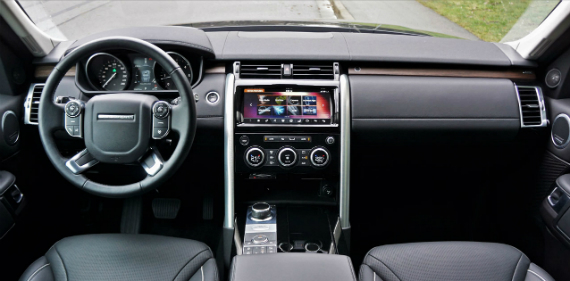
I happen to like the leisurely lope of a diesel and fully appreciate their savings at the pump, and I must say the Td6 performed flawlessly throughout my test, just like the 2017 Discovery Td6 I spent a week with last year. The two SUVs were optioned out similarly too, both in top-tier HSE Luxury trim, albeit this latest one finished in $710 Santorini Black instead of $710 Indus Silver, while improved with a few more upscale goodies as well.
My previous tester was missing this 2018 model’s $1,225 optional 21-inch alloys that look superb and enhance lateral grip, while additional enhancements included some chrome edging on the otherwise body-color door handles, a $2,500 Drive Pro package that builds upon the aforementioned standard Autonomous Emergency Braking system by adding Adaptive Cruise Control with Queue Assist, Blind Spot Monitor with Reverse Traffic Detection, Blind Spot Assist, Lane Keep Assist, a Driver Condition Monitor and Traffic Sign Recognition with an Adaptive Speed Limiter.
Additionally, my 2018 Discovery tester included a $2,320 optional rear seat entertainment system that features dual 8.0-inch monitors on the backsides of the front headrests, instead of last year’s left-side tablet holder and right-side coat hanger, plus a DVD changer, a really fancy looking remote, two WhiteFire digital headphones, and a secondary device interface on the backside of the front console (joining another one housed within that console) that gets fitted with two HDMI slots and two USB ports.
This latest Disco also came with a power-folding seat system that’s capable of automatically lowering and/or raising individual sides of the 50/50-split third row as well as either the 60 or 40 percent portion of the second row, or both simultaneously, this standard on HSE Luxury trim. What’s more, you can also power all seats up and down via the infotainment system or a smartphone app. This is the best of such systems I’ve ever experienced, and as helpful as the obvious convenience this provides, it goes about its business quickly compared to other powered seat systems I’ve used.
Right next to these buttons is switchgear for the powered liftgate and unique powered tailgate, the latter a beautifully finished carpeted shelf that folds down to provide a convenient place to load up to 661 lbs of heavier items on before sliding them inside the sizable cargo hold, while it also stops items from falling out when opening the liftgate, important being that cargo has a habit of shifting during travel. And by the way, if upgraded to the available air suspension, which comes standard with HSE Luxury trim, you can lower the rear of the SUV via that panel of buttons to make the tailgate’s lift-over height a bit easier to deal with. Either way the Discovery provides 34.6 cubic feet of cargo space behind the third row, 43.5 cubic feet aft of the second row, and 88.3 cubic feet with both rear rows lowered.
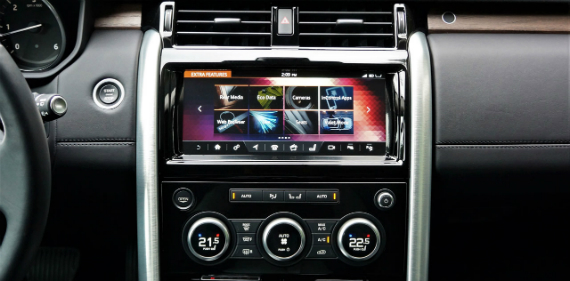
Both 2017 and 2018 models came with sumptuous Ebony (black) Windsor leather upholstery, the more conventional choice from four total colorway options that include a Glacier (light gray) and Ebony split, a caramel colored Vintage Tan and Ebony split, and a Nimbus (light beige) and Ebony combination, but take note this year’s Ebony interior adds a touch of class by including Nimbus piping, which matches the same colored standard headliner (an Ebony headliner is $360 extra), while standard open-pore Natural Shadow Oak veneer warmed up both cabins. Inlay options include no-cost Dark Satin Brushed Aluminum and Natural Charcoal Oak, while High Gloss Charcoal Oak adds $615 to the bill.
The 2018 model was devoid of side steps, making the reach up a bit more of a stretch, and didn’t come with the $285 optional 360-surround overhead parking aid, but its $2,225 7 Seat Luxury Climate Comfort package was a major bonus as it boasts 16-way power-adjustable front seats with massage, heated and cooled front and second-row outboard seats, heatable third row seats, and four-zone climate control with a comprehensive interface added to the backside of the front console.
Some other features found on both SUVs included a $410 set of black roof rails, a very well spent $185 for auto-dimming side mirrors, $130 for lane departure warning, and $105 for cabin air ionization, while this 2018 model included a $970 head-up display that projected speed, gear selection, and navigation directions onto the windshield, $410 for Advanced Tow Assist that literally backs the Discovery up to a trailer for you, which made the $665 Tow Equipment package prerequisite, upping trailering capacity to 8,200 lbs, plus a $1,230 Capability Plus Package featuring All Terrain Progress Control (ATPC), Terrain Response 2, and an Active Rear Locking Differential. All of these extras increased the price of my tester to $81,640 before freight and fees, which is $29,550 more than the base Discovery yet starting to approach full-size Range Rover levels of features and functions for considerably less than that model’s $87,350 starting price.
I bring up the big Range Rover because this new Discovery and that legendary luxury utility share the same underpinnings, as does the mid-size Range Rover Sport. This means the brand’s Integrated Body Frame (IBF) platform architecture has made way for an all-aluminum monocoque body shell and aluminum suspension design, allowing 1,058 lbs less curb weight than the LR4. As you can likely imagine the new Discovery is not only more efficient than its predecessor, as noted earlier, but a great deal more enjoyable to drive.
While the base SE comes standard with a fully independent coil-spring suspension setup and 19-inch alloys, my tester’s aforementioned 21s benefited from an air suspension upgrade that as noted comes standard with HSE Luxury trim. This made the most of the new Discovery’s lighter curb weight for an altogether more agile SUV, with sportier response during fast-paced curves that was especially noticeable when the weight shifted amid transitional corners. Of course, the Discovery remains a large SUV that’s never going to feel as athletic as something smaller like the Discovery Sport or Range Rover Evoque, but basing the new model on the same architecture as the amazingly capable Range Rover Sport has done wonders for the Disco, while it bodes well for a future SVR version of the latter.
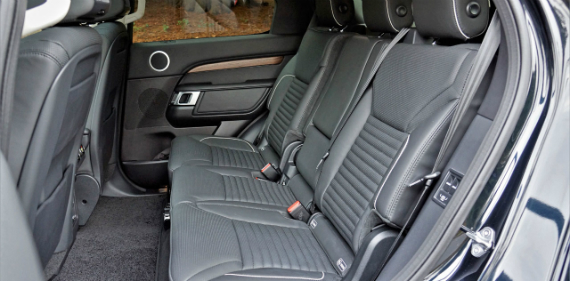
On that note I didn’t have opportunity to test the 2018 Discovery’s ability off pavement, but having driven other SUVs based on this architecture through mud, muck and over sand and rock I can only imagine it holds its own and then some. The Discovery includes the Land Rover brand’s legendary full-time four-wheel drive system featuring a locking center differential and optional rear locking diff, which as mentioned was included with my loaner, while its driver selectable Terrain Response system makes choosing the ideal setup for a given road/trail condition ultimately easy. Basically, Terrain Response provides a rotating dial for selecting Normal, Grass/Gravel/Snow, Mud and Ruts, Sand, and Rock Crawl, while the upgraded Terrain Response 2 allows the vehicle to sense and adjust the driveline setup to best respond to changing conditions automatically. That’s my kind of off-roading.
A compliant suspension is especially important when crawling over rocks and stumps, but it can be just as useful when trying to negotiate some of the back alleyways in my city. Whether blaming constant construction or sheer neglect, the Discovery’s air suspension made potholes and bumps less intrusive than they’d otherwise be, while good sound deadening and plenty of soft synthetic surfaces kept noise, vibration and harshness levels to a minimum. Still, a full-size Range Rover it’s not, which can be said of any SUV, as the priciest Landy would be my choice when it comes to full-on luxury. Considering the savings, however, the Discovery is finished very well, and once again better than its forebear.
What’s more, the seats were sensational, and not just the aforementioned massage function. Easy to set up for my body size and shape as well as various preferences like squab height and angle, seatback angle and more, they were inherently comfortable, plus on top of this I was able to power-adjust the side bolsters to snuggly pinch my backside, and manually adjust the headrest via airline-style butterfly wings. The Discovery provides ample steering wheel reach as well, powered in HSE trims and above, so my long-legged, short-torso frame was able to fit in ideally for optimal comfort and control.
All switchgear, which is very high in quality, was easy to reach, including the infotainment touchscreen, which I must say is an impressive high-resolution system with beautiful depth and contrast of colors, superb graphics and functions galore, one of my favorite features being the sonorous 14-speaker 825-watt Meridian audio system. Without getting granular, some HSE Luxury features not yet mentioned include that stereo, a heatable steering wheel, heated second-row seats, a standard third row for seven-passenger occupancy, extended stitched leather on the dash top and door uppers, interior mood lighting, chromed outer door handles, fog lamps, a high and low range two-speed transfer case, and more.
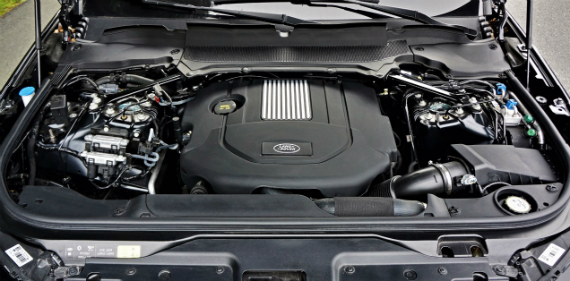
Features pulled up from lesser trims include LED headlights with signature DLRs, 20-inch alloys, tri-zone auto climate control, in-dash storage behind the climate-controls (it actually powers open), satellite radio, front seat memory, the powered panoramic sliding moonroof (the base SE gets a fixed panoramic sunroof), hardwood inlays, front parking sensors, the powered inner tailgate and more from the HSE, plus proximity keyless access, pushbutton ignition, an electromechanical parking brake, power-folding heatable side mirrors with approach lights, rain-sensing wipers, a color TFT multi-information display, an auto-dimming rearview mirror, rear parking sensors, a reverse camera, navigation, the InControl Remote phone app, Wi-Fi (for up to eight devices), a garage door opener, overhead sunglasses storage, a foot-activated powered gesture tailgate, hill descent control with off-road ABS, Hill Launch Assist, Gradient Acceleration Control (GAC), all the usual active and passive safety features, and more from the base SE.
I haven’t mentioned half of what’s standard or available, but suffice to say the 2018 Land Rover Discovery provides even more value within its mid-size luxury segment than the 2017 version, combined with excellent build quality, two highly efficient yet formidable powertrains, much improved high-speed handling, unsurpassed off-road performance, confidence-inspiring standard and optional safety, and the list goes on. Being an adventurer at heart I find it very easy to recommend.
Story credits: Trevor Hofmann, American Auto Press Photo credits: Karen Tuggay, American Auto Press Copyright: American Auto Press
